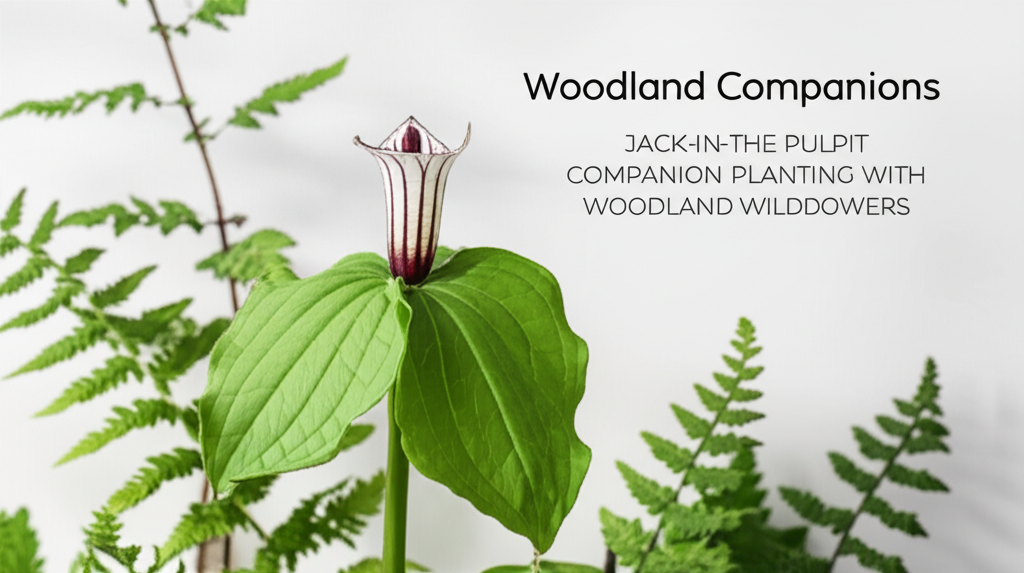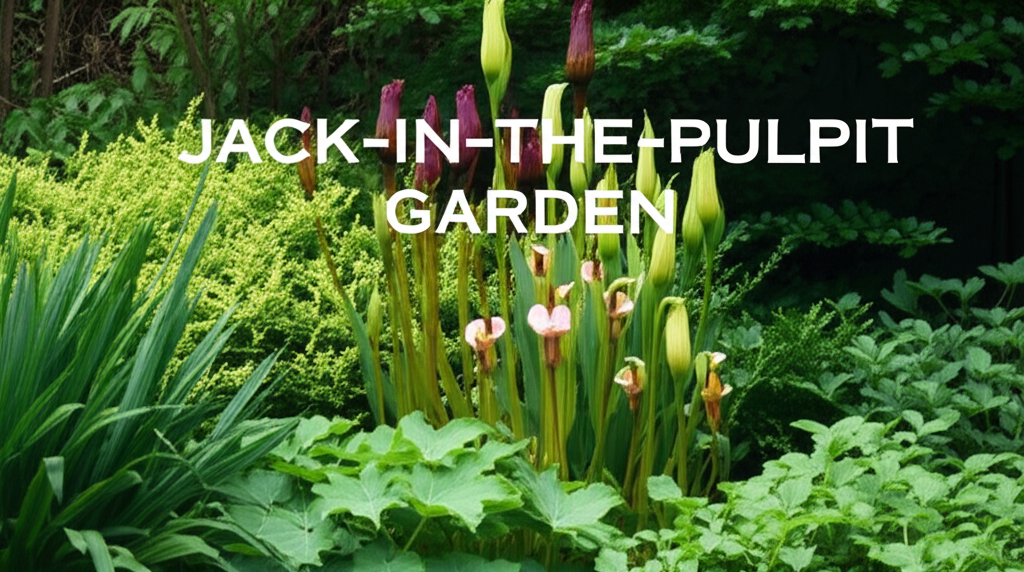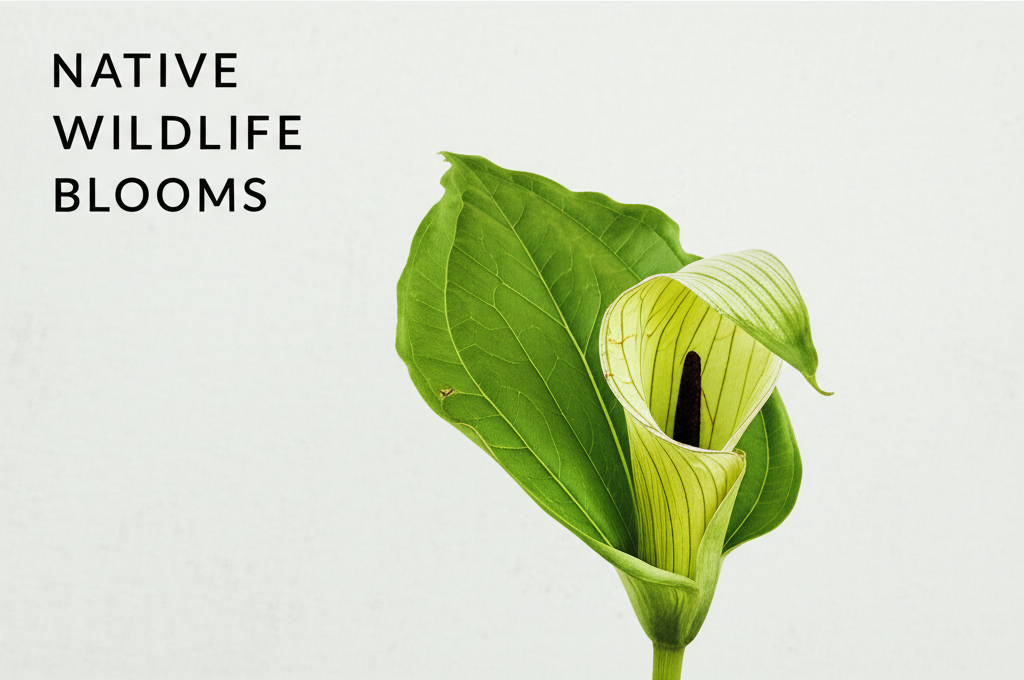Unveiling the Enchantment of Jack-in-the-Pulpit
Jack-in-the-Pulpit (Arisaema triphyllum) is a captivating woodland wildflower that adds a touch of intrigue and mystery to shady, moist gardens. Its unique spathe and spadix, resembling a preacher in a pulpit, have long fascinated botanists and gardeners alike. Beyond its striking appearance, this native perennial offers valuable ecological benefits and thrives when integrated into a well-planned companion planting scheme. This article delves into the art and science of companion planting with Jack-in-the-Pulpit, exploring its ideal companions, the benefits of such arrangements, and practical tips for creating a thriving woodland ecosystem.
Understanding the Needs of Jack-in-the-Pulpit
Before embarking on companion planting, it’s crucial to understand the specific environmental requirements of Jack-in-the-Pulpit. This plant is a true denizen of the forest floor, preferring:
- Partial to full shade: It thrives in dappled sunlight or the deep shade of deciduous trees.
- Moist, well-drained soil: Rich, humusy soil with consistent moisture is ideal. Avoid waterlogged conditions.
- Slightly acidic to neutral pH: A soil pH between 5.5 and 7.0 is generally preferred.
- Protection from strong winds: Its delicate foliage can be damaged by harsh winds.
By understanding these preferences, we can select companion plants that not only tolerate similar conditions but also contribute positively to the microclimate and soil health around the Jack-in-the-Pulpit.
The Principles of Companion Planting

Companion planting is an age-old gardening technique that harnesses the natural interactions between different plant species to create a more resilient, productive, and aesthetically pleasing garden. The core principles involve:
- Attracting beneficial insects: Certain plants can lure pollinators and predatory insects that help control pests.
- Repelling pests: Some plants emit scents or chemicals that deter common garden pests.
- Improving soil fertility: Nitrogen-fixing plants and those that attract earthworms can enrich the soil.
- Providing physical support: Taller plants can offer shade or support to smaller, more delicate ones.
- Enhancing aesthetics: Combining plants with complementary textures, colors, and bloom times creates a visually stunning display.
- Maximizing space: Utilizing vertical and horizontal space efficiently by planting species with different growth habits.
Applying these principles to a woodland garden featuring Jack-in-the-Pulpit allows for a symbiotic relationship between plants, fostering a healthier and more biodiverse ecosystem.
Ideal Companion Plants for Jack-in-the-Pulpit
The selection of companion plants for Jack-in-the-Pulpit should focus on species that share similar woodland habitat requirements and offer synergistic benefits.
Shade-Tolerant Groundcovers
Groundcovers help retain soil moisture, suppress weeds, and create a lush carpet beneath taller plants.
- Wild Ginger (Asarum canadense): With its large, heart-shaped leaves, wild ginger provides excellent ground cover and prefers the same moist, shady conditions as Jack-in-the-Pulpit. It also helps deter deer and slugs.
- Foamflower (Tiarella cordifolia): This delicate woodland native boasts attractive, lobed foliage and airy, white flower spikes in spring. It thrives in shade and moist soil, creating a beautiful textural contrast.
- Partridgeberry (Mitchella repens): A low-growing evergreen groundcover, partridgeberry features small, rounded leaves and produces attractive red berries in the fall. It tolerates shade and acidic soil, making it an excellent choice.
Spring Ephemerals
Many woodland wildflowers are ephemerals, meaning they complete their life cycle (bloom and leaf out) in early spring before the canopy of deciduous trees fully closes. They provide early season interest and benefit from the moisture and cool soil of early spring.
- Bloodroot (Sanguinaria canadensis): Known for its single, pure white flower that emerges before its distinctive blue-green leaves, bloodroot is a quintessential spring ephemeral that thrives in the same conditions as Jack-in-the-Pulpit.
- Trillium (Trillium spp.): The elegant beauty of Trillium, with its characteristic three-leaved whorl and striking solitary flower, is a hallmark of healthy woodland gardens. Various Trillium species are excellent companions, adding to the spring display.
- Mayapple (Podophyllum peltatum): This distinctive plant produces a single nodding white flower under its umbrella-like leaves. It spreads to form colonies and provides good ground cover in shady, moist areas.
Ferns for Texture and Shade
Ferns are indispensable in a woodland garden, providing lush texture, varying shades of green, and excellent shade.
- Maidenhair Fern (Adiantum pedatum): Its delicate, fan-shaped fronds on black stems add an airy, elegant touch. Maidenhair fern prefers moist, humus-rich soil and shade.
- Ostrich Fern (Matteuccia struthiopteris): This tall, dramatic fern unfurls large, vase-shaped fronds, creating a bold statement. It thrives in moist, shaded conditions and can help fill in gaps.
- Christmas Fern (Polystichum acrostichoides): An evergreen fern, Christmas fern provides year-round color and texture. Its leathery fronds remain attractive through winter, offering visual interest when other plants are dormant.
Shade-Tolerant Perennials for Extended Bloom
While spring ephemerals offer early season beauty, incorporating plants with later bloom times can extend the garden’s interest.
- Coral Bells (Heuchera spp.): Renowned for their stunning foliage in shades of purple, amber, and green, coral bells also produce delicate, airy flower spikes that attract hummingbirds and pollinators. They prefer shade and well-drained soil.
- Hosta (Hosta spp.): With their diverse leaf shapes, sizes, and colors, hostas are woodland garden staples. They provide excellent ground cover and tolerate shade well. Their late-season blooms are also attractive to pollinators.
- Bleeding Heart (Dicentra spectabilis): The iconic heart-shaped flowers of bleeding heart are a beloved sight in spring and early summer. It prefers moist, shady conditions and can complement the texture of Jack-in-the-Pulpit.
Benefits of Companion Planting Jack-in-the-Pulpit
Integrating Jack-in-the-Pulpit into a thoughtfully designed companion planting scheme offers numerous advantages for the gardener and the ecosystem.
Table 1: Key Facts and Comparison of Jack-in-the-Pulpit and Potential Companions
| Plant Name | Mature Height | Light Needs | Soil Moisture | Bloom Time | Key Companion Benefits |
|———————-|—————|——————|—————–|—————|———————————————————-|
| Jack-in-the-Pulpit | 1-3 feet | Partial to Full Shade | Moist, Well-drained | Spring | Unique visual interest, attracts pollinators |
| Wild Ginger | 6-12 inches | Shade | Moist | Spring | Ground cover, deters slugs/deer, retains moisture |
| Foamflower | 8-12 inches | Shade | Moist, Well-drained | Spring | Textural contrast, airy blooms, ground cover |
| Partridgeberry | 2-4 inches | Shade | Moist, Well-drained | Late Spring | Evergreen ground cover, attractive berries, soil retention |
| Bloodroot | 6-12 inches | Shade | Moist, Well-drained | Early Spring | Early season color, ephemeral beauty |
| Trillium (various) | 1-2 feet | Shade | Moist, Well-drained | Spring | Elegant blooms, spring ephemeral, woodland aesthetic |
| Mayapple | 1-1.5 feet | Shade | Moist | Spring | Ground cover, unique form, attracts pollinators |
| Maidenhair Fern | 1-2 feet | Shade | Moist, Well-drained | N/A | Delicate texture, airiness, shade provider |
| Ostrich Fern | 3-6 feet | Shade | Moist | N/A | Bold texture, shade provider, moisture retention |
| Christmas Fern | 1-2.5 feet | Shade | Moist, Well-drained | N/A | Evergreen color, year-round texture, shade provider |
| Coral Bells | 1-2 feet | Shade | Well-drained | Late Spring-Summer | Colorful foliage, attracts hummingbirds, late blooms |
| Hosta | 6 inches – 4 feet | Shade to Part Shade | Moist | Summer | Diverse foliage, ground cover, attracts pollinators |
| Bleeding Heart | 1-3 feet | Partial Shade | Moist, Well-drained | Spring-Early Summer | Iconic flowers, extends bloom, complements texture |
Ecological Advantages
- Biodiversity: A diverse planting of woodland wildflowers and companion plants supports a wider range of insects, birds, and other wildlife, creating a more robust ecosystem.
- Pollinator Support: Many companion plants, such as Coral Bells and Hostas, provide nectar and pollen for bees, butterflies, and hummingbirds, ensuring the pollination of your garden.
- Pest Management: While not a primary pest-repelling plant itself, companion plants like Wild Ginger can deter slugs and deer, indirectly protecting your Jack-in-the-Pulpit.
- Soil Health: Groundcovers and ferns help prevent soil erosion, retain moisture, and contribute organic matter as they decompose, enriching the soil over time.
Aesthetic Appeal
The layered textures, varying shades of green, and staggered bloom times of a well-chosen companion planting scheme create a dynamic and visually captivating woodland garden. The unique structure of the Jack-in-the-Pulpit stands out amidst the softer forms of ferns and the ground-hugging nature of other woodland wildflowers.
Establishing Your Woodland Garden: Practical Steps
Creating a successful woodland garden with Jack-in-the-Pulpit and its companions involves careful planning and execution.
Site Selection and Preparation
- Identify a suitable location: Choose an area that receives dappled shade or consistent partial shade throughout the day. Observe the light patterns in your chosen spot.
- Assess soil conditions: Test your soil for pH and drainage. Amend heavy clay soils with plenty of compost and organic matter to improve drainage and fertility. Sandy soils can benefit from added compost to increase water retention.
- Clear the area: Remove any invasive weeds or unwanted vegetation. Avoid disturbing existing beneficial soil organisms as much as possible.
Planting Techniques
- Planting depth: Plant Jack-in-the-Pulpit corms at a depth of about 3-4 inches, with the pointed end facing upwards.
- Spacing: Ensure adequate spacing between plants to allow for mature growth and air circulation. Refer to individual plant tags or descriptions for specific recommendations.
- Layering: Plant taller species towards the back or center of beds, with shorter groundcovers and ephemerals at the front or edges. Place ferns strategically to create visual interest and provide shade.
- Watering: Water thoroughly after planting to settle the soil and encourage root establishment.
Ongoing Care and Maintenance
- Watering: Maintain consistent moisture, especially during dry periods. Water deeply and less frequently rather than shallowly and often, encouraging deeper root growth.
- Mulching: Apply a layer of organic mulch, such as shredded leaves or compost, around your plants. This helps retain moisture, suppress weeds, and regulate soil temperature.
- Fertilizing: Woodland plants generally do not require heavy fertilization. A top-dressing of compost or a light application of a balanced organic fertilizer in early spring is usually sufficient.
- Pest and Disease Monitoring: Regularly inspect your plants for any signs of pests or diseases. Early detection and intervention are key. Generally, healthy plants in the right conditions are more resistant.
- Leaf Litter: Allow fallen leaves to remain on the garden floor in the fall. This natural mulch is highly beneficial for woodland plants, providing nutrients and habitat for beneficial organisms.
Pros and Cons of Companion Planting with Jack-in-the-Pulpit
While companion planting offers numerous advantages, it’s also important to consider potential drawbacks.
Table 2: Pros and Cons of Companion Planting Jack-in-the-Pulpit
| Pros | Cons |
|——————————————————————-|————————————————————————-|
| Enhanced biodiversity and a more complete ecosystem. | Increased competition for resources (water, nutrients) if not planned well. |
| Improved soil health through nutrient cycling and moisture retention. | Potential for over-crowding if plants are not spaced appropriately. |
| Aesthetic appeal with varied textures, colors, and bloom times. | Increased risk of some shared pests or diseases, though less common in diverse plantings. |
| Attracts beneficial insects for pollination and pest control. | May require more initial planning and selection of compatible species. |
| Natural weed suppression and reduced soil erosion. | Some companions may outcompete Jack-in-the-Pulpit if not managed. |
| Supports a more resilient garden less reliant on artificial inputs. | Sourcing native and appropriate companion plants can sometimes be challenging. |
Conclusion: Cultivating a Living Tapestry
Companion planting with Jack-in-the-Pulpit transforms a simple planting into a vibrant, interconnected woodland ecosystem. By carefully selecting plants that share its preferences for shade and moisture, and by understanding the principles of symbiotic relationships, gardeners can create a visually stunning and ecologically rich environment. The unique charm of the Jack-in-the-Pulpit is amplified when nestled amongst the diverse textures of ferns, the early blooms of ephemeral wildflowers, and the enduring foliage of shade-loving perennials. Embracing companion planting not only enhances the beauty of your garden but also contributes to the health and sustainability of your local environment, creating a truly captivating living tapestry for seasons to come.
html
<h2>Jack-in-the-Pulpit Companion Planting: Key Facts/Comparison</h2>
<table>
<thead>
<tr>
<th>Companion Plant</th>
<th>Benefits for Jack-in-the-Pulpit</th>
<th>Benefits for Companion</th>
<th>Light Requirements</th>
<th>Soil Preference</th>
</tr>
</thead>
<tbody>
<tr>
<td>Wild Ginger (<em>Asarum canadense</em>)</td>
<td>Provides ground cover, conserves moisture, suppresses weeds.</td>
<td>Benefits from shade and moisture provided by Jack-in-the-Pulpit.</td>
<td>Shade to partial shade</td>
<td>Rich, moist, well-drained</td>
</tr>
<tr>
<td>Ferns (e.g., Christmas Fern, Maidenhair Fern)</td>
<td>Offers dappled shade, retains moisture, adds aesthetic appeal.</td>
<td>Thrives in similar moist, shady woodland conditions.</td>
<td>Shade to partial shade</td>
<td>Rich, moist, well-drained</td>
</tr>
<tr>
<td>Foamflower (<em>Tiarella cordifolia</em>)</td>
<td>Low-growing ground cover, suppresses weeds, adds delicate bloom.</td>
<td>Benefits from the moisture and partial shade.</td>
<td>Shade to partial shade</td>
<td>Rich, moist, well-drained</td>
</tr>
<tr>
<td>Columbine (<em>Aquilegia canadensis</em>)</td>
<td>Attracts pollinators beneficial to Jack-in-the-Pulpit, adds seasonal color.</td>
<td>Can tolerate similar woodland conditions, benefits from moisture.</td>
<td>Partial shade to sun</td>
<td>Well-drained, average to rich</td>
</tr>
<tr>
<td>Trillium (e.g., Painted Trillium, Red Trillium)</td>
<td>Shared habitat needs, creates a natural woodland aesthetic.</td>
<td>Benefits from the moisture and protection of larger neighbors.</td>
<td>Shade to partial shade</td>
<td>Rich, moist, well-drained</td>
</tr>
</tbody>
</table>
<h2>Jack-in-the-Pulpit Companion Planting: Steps/Pros-Cons</h2>
<table>
<thead>
<tr>
<th>Aspect</th>
<th>Details</th>
</tr>
</thead>
<tbody>
<tr>
<td><h3>Steps for Planting</h3></td>
<td>
<ol>
<li><strong>Site Selection:</strong> Choose a location with dappled shade to full shade and consistently moist, well-drained soil rich in organic matter.</li>
<li><strong>Soil Preparation:</strong> Amend the soil with compost or leaf mold to improve fertility and moisture retention.</li>
<li><strong>Planting Companions:</strong> Plant companion species around the Jack-in-the-Pulpit corms, considering their mature size and spread. Group plants with similar needs.</li>
<li><strong>Watering:</strong> Water thoroughly after planting and maintain consistent moisture, especially during dry periods.</li>
<li><strong>Mulching:</strong> Apply a layer of organic mulch (e.g., shredded leaves, bark chips) to retain moisture, suppress weeds, and regulate soil temperature.</li>
</ol>
</td>
</tr>
<tr>
<td><h3>Pros of Companion Planting</h3></td>
<td>
<ul>
<li><strong>Improved Moisture Retention:</strong> Ground cover plants help keep the soil around the Jack-in-the-Pulpit consistently moist.</li>
<li><strong>Weed Suppression:</strong> Dense ground covers reduce competition from unwanted weeds.</li>
<li><strong>Enhanced Aesthetics:</strong> Creates a naturalistic woodland garden look with varied textures and blooms.</li>
<li><strong>Attracts Beneficial Insects:</strong> Flowering companions can attract pollinators and predatory insects.</li>
<li><strong>Soil Health:</strong> Decomposing organic matter from companion plants enriches the soil over time.</li>
</ul>
</td>
</tr>
<tr>
<td><h3>Cons of Companion Planting</h3></td>
<td>
<ul>
<li><strong>Competition:</strong> Overly aggressive companions might compete for resources like light, water, or nutrients if not managed.</li>
<li><strong>Disease Transmission:</strong> Planting too closely might increase the risk of transferring certain soil-borne diseases, though less common with healthy woodland natives.</li>
<li><strong>Slower Establishment:</strong> It may take time for companion plants to establish and provide full benefits.</li>
<li><strong>Maintenance:</strong> May require occasional thinning or removal of overgrown companions to ensure optimal conditions for the Jack-in-the-Pulpit.</li>
</ul>
</td>
</tr>
</tbody>
</table>


